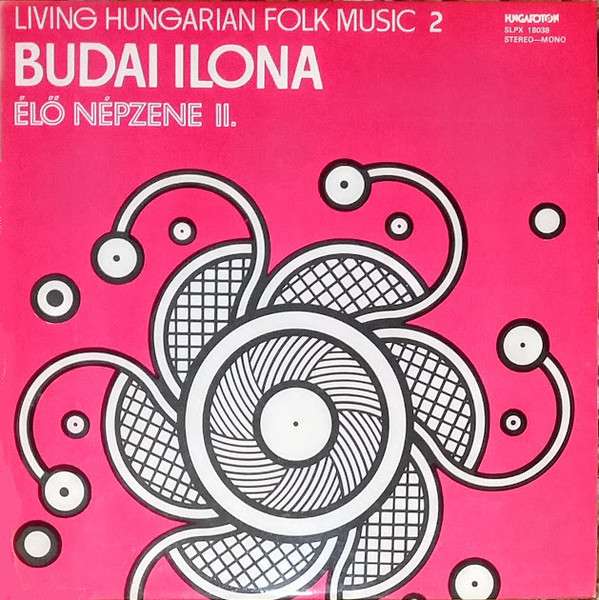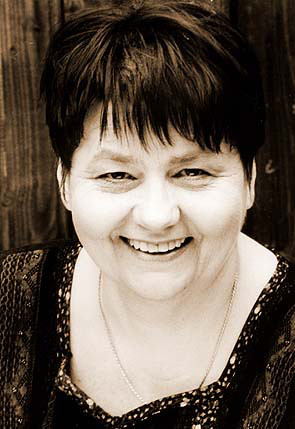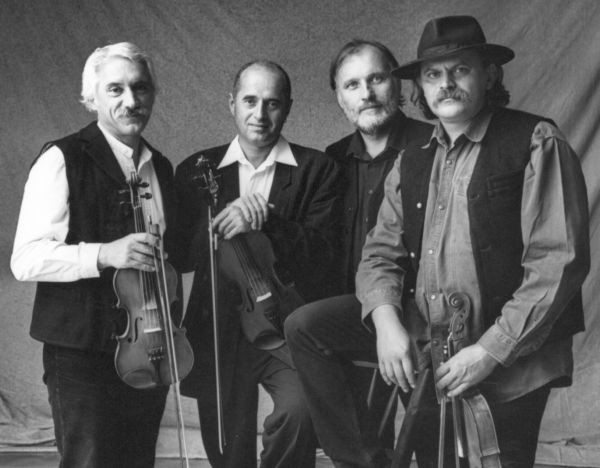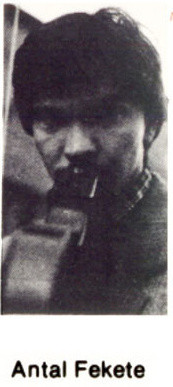
Budai Ilona
Living Hungarian Folk Music 2
Album HU 1978 on Hungaroton label
Folk (Folk, Népzene)
Budai Ilona 1951-ben született a Győr megyei Gyömörén. Nevét nem az ismert népballadától kölcsönözte, de a balladák és az archaikus népdal édeslányaként érkezett abba az áramlatba, amely ma a népzene új hullámaként ismeretes. Az áramlat emelte őt: a „Ki mit tud?”, a „Röpülj, páva” első nagy vetélkedői országos színpadhoz juttatták, s ő olyan énekléssel töltötte be a termeket, melynek üdesége, meleg tisztasága és emelkedett, fényes zengése a népdal legbensőbb tartalmát keltette életre. A népies műdalon és magyarnótán iskolázott előadói stílustól érintetlenül, hangszeres kíséret nélkül énekelt kezdettől. Később – mint e lemezen is – rokon-ízlésű együttesekkel is társult, de becsvágya ugyanaz maradt: póztalanul szolgálni a népdal eredeti szellemét – a legszebbekét. Természetes, hogy ezeket keresve ő is a mezőségi és a csángó magyarság dalkincsében talált zenei otthonára, s itt tanulta meg a népdal hiteles előadásának törvényeit. Külön szerencséje, hogy alkata is olyan, mintha a népdal jegyében fogant volna, s egyéniségének varázsa és a dalé, melyet előad, az együvé tartozó természeti jelenségekhez hasonlítja éneklését. Ezért, hogy kritikusai – immár 10 éve - mesterségbeli tudását is e varázslat részeként észlelik és becsülik. A népzene emberi jelleget, minőséget kifejező hatalmát vélik felismerni benne: a gyógyító, szabadító és hűségre kötelező szépség erejét. „te vagy a jó sugarasító” – írja róla Nagy László – „jó hitem nyerge, rosszat irtó /hogy jobb magamhoz is jussak el / emelj föl engem, hadd siessek, / vágj utat árva földieknek / szárnyaddal s torkod élivel!” Csak találgatni lehet, hogy ehhez a hozományhoz ki adott többet: szülei, az egyszerű munkásemberek, a ménfőcsanaki gimnázium, a soproni óvónőképző, a Bartók Béla Zeneművészeti Szakiskola, ahol tanult, vagy a Páva, mely felröppentette s a közönség, amelynek szeretetét kezdettől érezhette? – Tény, hogy önmagára ismert benne a mai fiatalság. S ez a találkozás a népzene jövője szempontjából is reményre jogosító bizonyosság. Ez a lemez első nagylemeze Budai Ilonának, határkő a maga énekesi pályáján s a mozgalom folyamatában is: a beérkezés dokumentuma, s lehet a további zenei honfoglalás bázisa is. Kiss Ferenc Ilona Budai was born in Gyömöre, Győr coutny, in 1951. She did not borrow her name from the popular Hungarian folk ballad, but she became part of the current known as the new wave of folk music as a direct heir to the ballad and the archaic folk-song. She was lifted by the waves of this current: the first major competitions organized by the Hungarian Television, the „What Can You Do?” and the „Fly, Peacock!” ensured her a nation-wide stage, and she filled it with singing whose refreshing, warm purity and elevated, sparkling tone evoked the innermost meaning of the folk-song. From the very beginning she has sung without instrumental accompaniment, and untouched by a performing style developed in the singing of pseudo-folk art songs. Later – as in the present recording – she joined forces with ensembles of related tastes, but always remained true to her aspiration: to serve the original spirit of the folk-song in an unassuming rendition, endeavouring to select the most beautiful ones. It is only natural that in her search for these songs she too found her way to the folk-song heritage of the Hungarians living in the region known as the Mezőség and Moldavia (the latter being the Csángós), and here she also became familiar with the laws of the authentic rendition of the folk-song. Ilona Budai is particularly fortunate that her make-up seems to have been conceived in the spirit of the folk-song, and the charm of her personality together with the magic of the song she sings, elevates her performance to an interplay of natural phenomena. This is the reason her critics for the past ten years have acknowledged and esteemed her artistic attainment as part of this magic. They believe they recognize in it the power of folk music to express human character and quality – the healing, liberating force of beauty, which also compels fidelity. „You are the radiating benevolence”, the poet László Nagy writes of Ilona Budai, „the saddle of my good faith, destroying evil / so that I may attain my better self / lift me, let me hasten / cut a path for lonely mortals / with your wings and the edge of your throat!” This is Ilona Budai’s first LP, a landmark, as it were, both in her career as a singer and in the course of the movement, serving equally as a proof of her success and the basis for further conquests. Ferenc Kiss Issued in non-gatefold laminated cover with a 4-page insert sheet. Very similar to Living Hungarian Folk Music 2, but slightly different back cover (Budai Ilona image is not same).
Musicians
 | Budai Ilona voc, vocals, album by |
 | Péter Éri vl, cb, double bass |
 | Arányi Tibor , lacquer cut by |
 | Ernőffy Olivér , lacquer cut by |
 | Lázár Katalin voc, vocals |
 | Muzsikás , *1973 HU vocals, music by |
 | Antal Fekete vl, Ütőgardon, gardon |
Producers
| József Zelnik edited by |
Album Tracks
| No | Title | Artist | Composer | Duration |
|---|---|---|---|---|
| 1 | A1. Csango And Bukovinan Folk-Songs | Budai Ilona | ||
| 2 | The Bright Sun | Budai Ilona | ||
| 3 | The Sunbeams Shine Forth | Budai Ilona | ||
| 4 | I'd Go Out Into My Little Garden | Budai Ilona | ||
| 5 | For Us The Loveliest Evening | Budai Ilona | ||
| 6 | A2. Dance Tunes Of Gyimes | Budai Ilona | ||
| 7 | May My Boots | Budai Ilona | ||
| 8 | Fast Hungarian (Whoop It Up!) | Budai Ilona | ||
| 9 | A3. Folk-Songs From Nograd County | Budai Ilona | ||
| 10 | Oh My Maiden Headdress | Budai Ilona | ||
| 11 | Weep, Just Weep | Budai Ilona | ||
| 12 | Doughter, Doughter | Budai Ilona | ||
| 13 | A4. Prisoners' Songs From The Mozoseg | Budai Ilona | ||
| 14 | If I Go Up Tp Kolozsvar | Budai Ilona | ||
| 15 | Down The Road | Budai Ilona | ||
| 16 | A5. Palots Ring-Dances | Budai Ilona | ||
| 17 | I Have Fenced Round The Tisza And The Danube | Budai Ilona | ||
| 18 | I Have No Other Care | Budai Ilona | ||
| 19 | Hey Rosemary | Budai Ilona | ||
| 20 | A6. Folk-Songs From Szatmar County | Budai Ilona | ||
| 21 | I'm Not In The Prime Of Life | Budai Ilona | ||
| 22 | Blue Violet | Budai Ilona | ||
| 23 | The Wind Drives The Waves | Budai Ilona | ||
| 24 | A7. Lament From The Mezoseg: | Budai Ilona | ||
| 25 | The Rain Nicely Lashes The Flowers | Budai Ilona | ||
| 26 | B1. Folk-Songs From Szek | Budai Ilona | ||
| 27 | The Moonlight Shines In | Budai Ilona | ||
| 28 | Late At Night | Budai Ilona | ||
| 29 | How I Would Be | Budai Ilona | ||
| 30 | B2. Ring-Dances Of Sarkoz | Budai Ilona | ||
| 31 | I'm A Famous Girl In Lovely Sarkoz | Budai Ilona | ||
| 32 | Get On, Get On My Bride | Budai Ilona | ||
| 33 | B3. Casago Folk-Ballad: | Budai Ilona | ||
| 34 | Fair Ilona Marton | Budai Ilona | ||
| 35 | B4. Folk-Songs From Gomor County | Budai Ilona | ||
| 36 | Oh, How Much You Travel Bright Star | Budai Ilona | ||
| 37 | I Wouldn't Give A Penny For A Lad | Budai Ilona | ||
| 38 | B5. Folk-Songs Of Valaszut | Budai Ilona | ||
| 39 | If You Knew | Budai Ilona | ||
| 40 | If The Furrow Curls | Budai Ilona | ||
| 41 | Winter-Summer Orache | Budai Ilona | ||
| 42 | B6. Folk-Songs Of Magyarpalatka | Budai Ilona | ||
| 43 | Beyond The Water | Budai Ilona | ||
| 44 | I'll Buy Three Red Kerchiefs | Budai Ilona |
